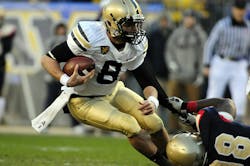7 Secrets to Building Teamwork
As we saw during Super Bowl LI last month, the best team usually wins. It doesn’t prevail by luck or by superstar efforts, but rather by coordinated teamwork. We now know that the Patriots—the best team—won in a historic overtime game. What does this have to do with home building? It illustrates a fundamental principle: Teamwork is everything.
Recently, I had the pleasure of sharing the stage with Garrison Wynn, who studies and coaches some of the world’s largest corporations. He stated that companies that operate as a team are 40 percent more successful. While this may be true for the business world in general, it significantly understates the impact of teamwork in home building. According to a recent study of 4,000 homeowners, home builders with teamwork ratings of Very Good achieved an impressive 100 percent Willingness to Refer (WTR), while Poor teamwork ratings yielded just 14 percent WTR. This difference suggests a 615 percent premium on teamwork, which is huge.
Clearly, customers are saying they don’t want heroes, superstars, or mavericks. They want people who demonstrate the characteristics of a team: self-discipline, clear communication, knowing the playbook, and respecting the rules and other team members.
We’ve all seen team members who, when a mistake is made, suffer from the hero syndrome: They disassociate themselves from an issue, criticize the team, and anoint themselves as saviors. The behavior shows lack of respect for fellow team members and places self-image above team success. Unfortunately, this kind of fracture happens all too often. Poor teamwork can translate to salespeople breaking the no-changes after purchase rule, field superintendents paying vendors for nonconforming work, or a warranty technician telling a customer, “That item was on the superintendent’s punch list, so it’s not my problem.”
Poor teamwork can hobble internal operations, too. A controller who believes that he or she controls people not finances; an estimator consistently late on pricing customization changes; an office administrator who is a serial gossiper; or, worst of all, a company leader who insists that homes close on a particular date irrespective of completeness. All are examples of independence rather than teamwork.
The High Cost of Hero Syndrome
Colleagues and I recently conducted a study of 4,000 homeowners using Voice of the Customer data on perceived teamwork and homeowner-referring activity. The results revealed much about lack of teamwork and its cost. A customer who rates teamwork very highly refers an average of 3.92 family and friends to his or her home builder. A customer who rates teamwork poorly refers just 0.48.
A teamwork-driven company usually yields 3.92 prospect referrals per happy homeowner at a conversion rate of 1:3, or 1.3 future sales per homeowner. With a new home’s average value of $380,000 and an 18.9 percent gross profit per house, future gross profit of a great teamwork-rated builder is $93,366 per home. For customers with poor teamwork ratings, future referral revenue is just $14,938. (We can safely assume that the majority of these 0.48 referrals were prior to the customer experiencing poor teamwork.) So, that superhero who isn’t a team player would need to produce at least double the homes (sales or field production closings) to be at financial breakeven in the long run. Consider the more constructive path: Purge poor teamwork for better long-term success and you’ll see rapid improvement in the work environment and employee morale.Identifying Hero Syndrome
Hero syndrome happens when a member of a team feels the need to be viewed as the most important or the MVP in the eyes of the customer. A hero or non-team–player can easily be identified by both words and actions.
How an employee uses pronouns reveals a lot. Heroes or non-team–oriented staff tend to make frequent use of first-person pronouns—me, my, I, mine. A salesperson may tell a customer, “I have five plans for you to choose from,” or “My builder is a good guy,” or “Let me see what I can do for you on this late change order.” On the field manager’s side, a non-team player would say, “my painter,” “I have a fix-it guy,” etc. Another example is employees who say “they” when referring to the company or team—indication that this person probably doesn’t feel connected to the team. On the other hand, if that employee of yours says “we,” it probably means they see themselves as part of the company or team.
Hero syndrome happens when a member of a team
feels they need to be viewed as the most important,
or the MVP, in the eyes of the customer.
7 Secrets of Teamwork
1. PICK TEAM PLAYERS
Look for new hires who have demonstrated their version of teamwork: sports, any kind, of band, choir, church, community work, or volunteer work. Listen closely for team-talk pronouns and descriptions of team success. Do they talk about how they contributed to team goals, or do they only mention their personal success? When discussing failures, do they describe them as someone else’s fault? (“They gave me terrible lots to sell,” “Their subcontractors were awful.”)
2. CRAFT SOME PLANS
With team members in place, management should define an operational plan and a customer-experience plan. Once these plans are defined, repeated teaching and practice are the only sure ways to synchronize all your team members. Work hard to develop the perfect plan. Almost every play in sports is designed for a touchdown, basket, or goal. The most successful coaches are leaders who start with the perfect plan and make intelligent, real-time adjustments
as needed.
3. MEASURE PERFORMANCE
Identify the Key Performance Indicators for every member of your team. If you can’t identify what each team member is specifically required to do, or a measurement for achievement, then you may have an unnecessary role. Performance indicators should be specific at the corporate, community, and individual levels. At the individual level, there should be at least five requirements of each team member (sales, selections, mortgage, superintendent, warranty, trade partners, etc.) for monitoring the customer experience.
4. MONITOR PERFORMANCE
Measuring alone doesn’t cut it. Frequent monitoring is critical for teamwork and success. In most competitions there are game clocks, scoreboards, streaming statistics, and replays. The leader/coach must be able to recognize and react to critical statistics. It is almost guaranteed that leaders/coaches, staff, and customers can instantly recognize team players versus heroes. One role of every leader/coach is to determine both a short- and long-term cost/benefit analysis of every member’s productivity and their contribution to the team’s work.
5. HUDDLE UP
From beach volleyball to football to home builders, smart teams huddle up before they play. When you do, listen to staff and communicate with them daily. Several top-performing home builders and National Housing Quality Award recipients hold short stand-up meetings every morning to stay in touch with daily rhythms and share company updates. Communication appears to be one of the secrets to teamwork. Our consulting work with employee-satisfaction surveys consistently points to communication as one of the most important workplace attributes. An over-reliance on digital communications by management or staff can actually be counterproductive on the teamwork scoreboard. The preferred medium is face to face.
6. LISTEN TO THE VOICE OF THE CUSTOMER
VOC is one of the critical metrics to monitor. Some 30 years in the business and lots of analytics have shown me that the customer really does know best. Ninety-seven percent of them are reasonable people and only 3 percent are impossible to please. If your customers are sharing feedback with more than 3 percent negative ratings/commentary in any one area, then your company is likely experiencing teamwork slippage resulting in a customer-satisfaction variance. While some customer-satisfaction metric variances may be minor, the big one is teamwork. As we saw in the earlier calculation, missteps in this area can cost nearly $100,000 per occurrence.
7. IF YOU NEED TO, CALL AN AUDIBLE
Team productivity excels when a leader or coach can recognize patterns and make smart plan changes on the fly. The hardest part is communicating those changes well. Don’t waste time defending the original plan; almost all plans require change. Alternate plays at the line of scrimmage are successful because the team has practiced changing course. (The Patriots made half-time adjustments that saved the game.) Home builders’ plans require frequent adjustments for reasons ranging from land challenges, late deliveries, delayed closings, changing interest rates, price increases, and staff turnover. Having team players, great teamwork, and good leadership and coaching pays huge dividends. For every home sold by a company with a teamwork culture, at least one additional future referral sale awaits. It’s also known as return on customer satisfaction. Correspondingly, for every non-teamwork–based sale, there are no future referral sales and sometimes even sales dissuasion. Creating a positive work environment and deeper employee engagement means that building homes will be much more rewarding, financially and emotionally.


